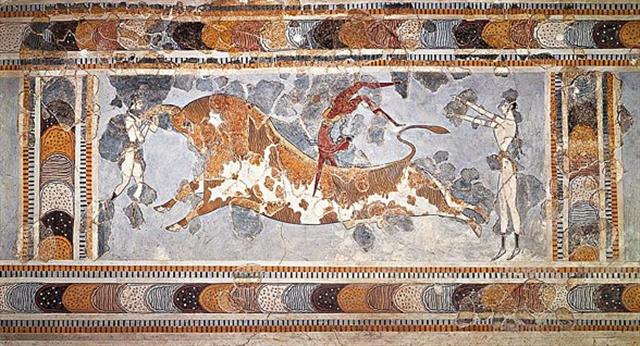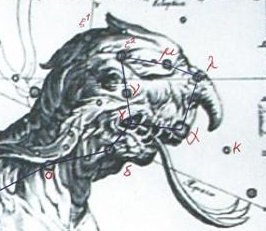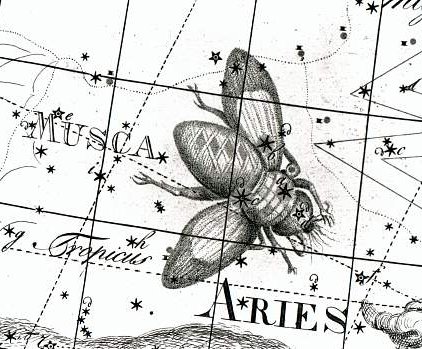159. From Regulus to Spica
there were 50 days - equal to the number of
days before Venus returned to the horizon in
the west as Evening Star:
|
314 |
 |
47 |
 |
 |
 |
|
Ca6-11 (151) |
Ca8-1 |
Ca8-2 |
Ca8-3 (202) |
|
te heheu ke - te
niu kua huri |
Etoru marama |
|
SADALMELIK (*334) |
ν Phoenicis (17.4), κ Tucanae (17.6) |
no star listed (18) |
ADHIL = ξ Andromedae
(*19) |
|
REGULUS (*152 = *334 - 182) |
σ
Virginis (200.4) |
γ Hydrae
(201.0), ι Centauri (201.4) |
SPICA
= α Virginis,
ALCOR
= 80 Ursae Majoris
(*202 = *19 + 183) |
|
Aug 20 (232) |
Oct 7 (280) |
8 |
9 |
|
║Aug 16 (*148) |
║Oct 3 (*196) |
4 |
5 |
|
'July 24 (*125) |
'Sept 10 |
11 (254) |
12 (*175) |
|
"July 10 (*111) |
"Aug 27 |
28 (240) |
29 (*161) |
|
JUNE 17 (168 = 2 * 84) |
AUG 4
(*136) |
5 |
6 (218 = 282 - 64) |
|
148 = 152 - 4 |
196 |
197 |
198 = 218 - 20 |
|
314 + 51 = 365 |
|
... Proclus informs us that the fox
star nibbles continuously at the
thong of the yoke which holds
together heaven and earth; German
folklore adds that when the fox
succeeds, the world will come to its
end. This fox star is no other than
Alcor, the small star g near
zeta Ursae Majoris (in India
Arundati, the common wife of the
Seven Rishis, alpha-eta Ursae ...
The Arabs in the desert regarded it
as a test of penetrating vision; and
they were accustomed to oppose 'Suhel'
to 'Suha' (Canopus to Alcor)
as occupying respectively the
highest and lowest posts in the
celestial family. So that Vidit
Alcor, et non lunam plenum, came
to be a proverbial description of
one keenly alive to trifles, but
dull of apprehension for broad facts
...
 |
We can then compare with the position of
Bharani 8 days after Cb1-6 when Venus had
been 'covered up'. I.e. corresponding to the
number of nights before Venus returned to
visibility at the horizon in the east to
become Morning Star:
 |
5 |
 |
 |
 |
 |
|
Cb1-6 (398) |
Cb1-12 (354 + 50) |
Cb1-13 |
Cb1-14 (350 + 8 * 7) |
Cb1-15 (407) |
|
te pahu |
manu rere - kua rere ga manu
- ki te ragi |
eaha te nuku erua |
koia kua huki |
e niu tu |
|
Al Ghafr-13 (Covering) /
Svāti-15
(Very Good)
TAHUA-TAATA-METUA-TE-TUPU-MAVAE
ARCTURUS, SYRMA (*215) |
31 Bootis (222.0),
YANG MUN (South Gate) = α Lupi
(222.1),
RIJL AL AWWA (Foot of the
Barker) = μ Virginis
(222.5), ο Bootis (222.9) |
IZAR (Girdle) = ε Bootis
(223.0),
109 Virginis, α Apodis (No Feet)
(223.3), μ Librae (223.8) |
Al Zubānā-14a
/
Visakha-16 (Forked) /
Root-3 (Badger)
ZUBEN ELGENUBI (*224) |
KOCHAB (Kakkab, the Star) = β
Ursae Min.
(225.0), ξ Librae (225.7) |
|
Oct 22 (295) |
Oct 28 (300 + 1) |
29 |
30 |
31 |
|
MIRA (*33 = *215 - 182) |
μ
Arietis (39.4),
HEAD OF THE FLY = 35 Arietis
(39.6),
KAFFALJIDHMA = γ Ceti,
θ Persei (39.8) |
π
Ceti, ο Arietis (40.0),
ANGETENAR (Bend in the River) =
τ╣ Eridani,
μ Ceti (40.2),
RIGHT WING = 39 Arietis
(40.9) |
BHARANI (*41 = *224 - 183) |
TA LING (Great Mound)
= τ
Persei (42.4) |
|
April 23 |
April 29
(118 + 1) |
30 |
May 1 (121) |
2 |
|
'March 27 (*6) |
'April 2 (92 = 91 + 1) |
3 |
4
(*14 = *41 - 27) |
5 |
|
"March 13 (*358) |
"March 19 (*364) |
3-20 (*365) |
0h (*366) |
"March 22 (*1) |
|
FEBR 18 (*335) |
BIS-SEXTUM |
FEBR 25 |
26 (*343 = *366 - 23) |
27 (58 = 122 - 64) |
|
29 |
35 |
36 |
37 = 41 - 4 |
38 = 58 - 20 |
|
394 = 398 - 4 |
400 = 35 + 365 |
401 |
402 = 406 - 4 |
403 |
|
The sequence of heliacal star
dates in the text seems here to
make a jump ahead with 1 place,
because *366 = 365 + 1 and from
Arcturus, Syrma (*215) to Zuben
Elgenubi (*224) there were not 9
but 8 days. |
|
... The leap day
was introduced as part of the
Julian reform. The day following
the Terminalia (February 23) was
doubled, forming the 'bis
sextum - literally 'double
sixth', since February 24 was
'the sixth day before the
Kalends of March' using Roman
inclusive counting (March 1 was
the 'first day'). Although
exceptions exist, the first day
of the bis sextum
(February 24) was usually
regarded as the intercalated or
'bissextile' day since the third
century. February 29 came to be
regarded as the leap day when
the Roman system of numbering
days was replaced by sequential
numbering in the late Middle
Ages ... |
 |
These 8 nights when Venus
was absent in the night sky could
possibly also be reflected in the glyphs
(and the words of Metoro) 365 days
earlier:
 |
 |
 |
|
Ca2-7 (33 = 398 - 365) |
Ca2-8 |
Ca2-9 |
|
manu rere |
e tara tua |
tagata oho |
|
θ Arietis (33.3),
MIRA = ο Ceti
(33.7) |
no star listed (34) |
ξ Arietis (35.0), ρ Ceti
(35.4), ξ▓ Ceti (35.9) |
|
April 23 |
24 |
25 (115) |
|
... Mira also known
as Omicron
Ceti (ο
Ceti,
ο
Cet), is a red giant star
estimated 200-400 light
years away in the
constellation Cetus. Mira is
a binary star, consisting of
the red giant Mira A along
with Mira B. Mira A is also
an oscillating variable star
and was the first
non-supernova variable star
discovered, with the
possible exception of Algol.
Apart from the unusual Eta
Carinae, Mira is the
brightest periodic variable
in the sky that is not
visible to the naked eye for
part of its cycle ...
 |
 |
 |
 |
 |
 |
 |
|
Ca2-10 |
Ca2-11 |
Ca2-12 |
Ca2-13 |
Ca2-14 |
Ca2-15 (41) |
|
ki te
kea |
tagata
oho ki roto o to vai |
kua
noho te kea |
kua
hua te rima |
tagata
oho |
ki te
vai |
|
σ Ceti (36.9) |
ν Ceti (37.9) |
ν Arietis (38.5), δ, ε
Ceti (38.8) |
μ
Arietis (39.4),
HEAD OF THE FLY = 35 Arietis
(39.6),
KAFFALJIDHMA = γ Ceti,
θ Persei (39.8) |
π
Ceti, ο Arietis (40.0),
ANGETENAR (Bend in the River) =
τ╣ Eridani,
μ Ceti (40.2),
RIGHT WING = 39 Arietis
(40.9) |
Bharani-2 /
Stomach-17
(Pheasant)
π Arietis (41.2),
MIRAM = η Persei
(41.3),
BHARANI
= 41 Arietis
(41.4),
τ▓ Eridani, σ Arietis
(41.7) |
|
April 26 |
27 |
28 |
29 |
30 |
May 1 (11 * 11) |
 |
|















